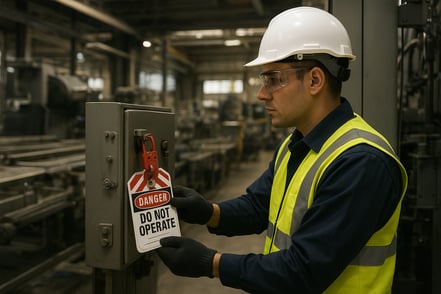Manufacturing is a complex, precision-driven industry where employee training directly impacts productivity, safety, and profitability. Traditional methods of training, while familiar, often fail to deliver the realistic, immersive experiences required for mastering critical skills. Virtual Reality (VR) training in manufacturing is becoming an innovative and effective solution to address key industry challenges like by providing risk reduction, enhanced learning, and cost efficiency. Let's explore five impactful benefits of virtual reality training in manufacturing and why manufacturers are rapidly embracing this transformative technology.
1. Enhanced Safety and Risk Reduction in Manufacturing
Manufacturing facilities often involve hazardous tasks, and mistakes can result in severe injuries, operational downtime, and financial liabilities. One advantage of VR training in manufacturing is its ability to provide realistic, immersive scenarios without real-world risk.
Employees can practice dangerous operations safely, encountering potential hazards virtually before ever facing them on the production floor. This proactive training significantly reduces workplace accidents and incidents, ensuring a safer environment and minimizing liability costs
2. Learning Faster with Improved Retention
Virtual Reality provides immersive and experiential learning opportunities that traditional methods simply can't replicate. VR-trained employees have better knowledge retention with that training closely mirrors real-life experiences that enhance cognitive engagement and muscle memory.
Studies consistently demonstrate that manufacturing workers trained with VR master tasks more quickly, need fewer retraining sessions, and exhibit greater confidence and efficiency. As a result, manufacturers experience reduced onboarding times and higher productivity.
3. Cost Efficiency and Resource Optimization
Traditional training in manufacturing often involves substantial expenses related to equipment downtime, consumables, instructor fees, and facility usage. VR training significantly reduces these costs by simulating equipment and scenarios virtually, eliminating the wear-and-tear associated with physical machinery.
Moreover, once developed, VR training modules are repeatable without additional expense, making the training scalable and cost-effective. These long-term cost savings translate into better resource allocation and operational efficiency, benefiting manufacturers significantly.
4. Consistent and Customizable Training Experiences
Achieving consistency across various trainers, shifts, and manufacturing sites is a persistent challenge. VR training resolves this issue by offering standardized, customizable experiences that replicate a company's specific equipment and operational procedures.
Each employee receives uniform training, ensuring consistent competencies across the workforce, irrespective of location or shift. This consistency drives uniform quality and productivity standards, enhancing overall operational efficiency.
5. Real-Time Performance Tracking and Feedback
Traditional training methods often lack precise analytics, making it challenging to measure training effectiveness. VR training platforms in manufacturing integrate robust analytics tools, enabling real-time performance tracking.
Supervisors gain instant insights into skill gaps, progress levels, and performance metrics, allowing them to provide immediate corrective feedback. This detailed performance tracking supports personalized training plans, optimizes employee performance, and facilitates continuous improvement.
Why Implementing VR Training in Manufacturing Matters
Using Virtual Reality (VR) training in manufacturing offers clear benefits beyond adopting new technology. VR helps manufacturers improve workplace safety, reduce risks, lower training expenses, and develop skilled employees. As the manufacturing industry changes, companies using VR training gain a competitive advantage through better-prepared workers and improved operational efficiency.
VR Training: Adaptable, Collaborative, and Future-Proof
A major benefit of VR training in manufacturing is its adaptability. As industry standards and technologies change, VR training modules can quickly be updated, helping employees stay skilled with the latest tools and processes. VR also supports team collaboration by enabling workers to interact and solve problems together in virtual environments, improving teamwork and productivity.
Moreover, the initial investment in VR technology quickly pays for itself. Reduced training times, fewer workplace incidents, improved retention, and higher productivity yield substantial returns, justifying the upfront costs.
Final Thoughts: Position Your Manufacturing Firm as a Leader with VR
Adopting VR training in manufacturing isn't just about new technology—it's about building a safer, more skilled workforce. By using VR's immersive experiences, manufacturers can lower operational risks, enhance employee skills, and encourage continuous improvement and teamwork.
As virtual reality becomes more common in manufacturing, companies using VR training will stand out as industry leaders. By adopting this innovative approach, manufacturers can stay competitive, improve employee skills, and position themselves for future success.




Comments